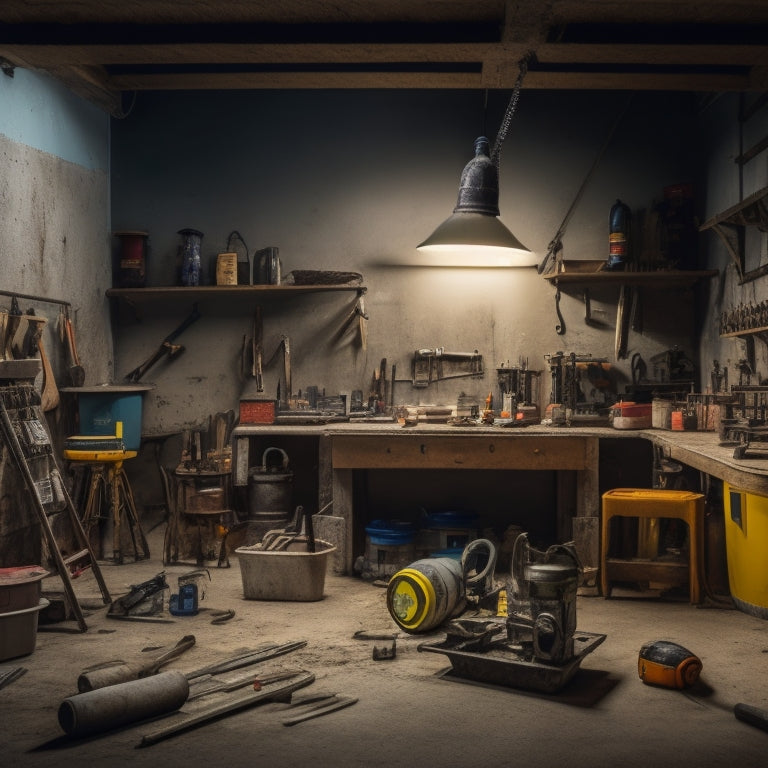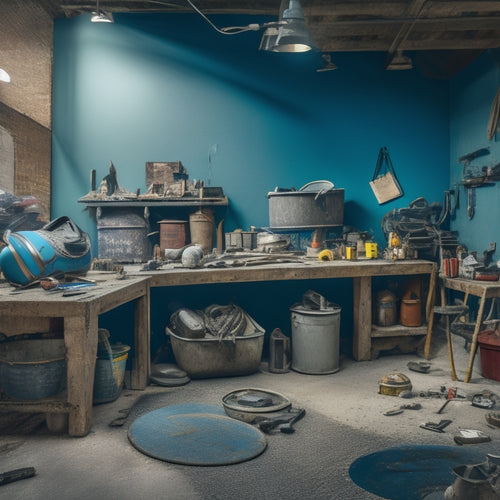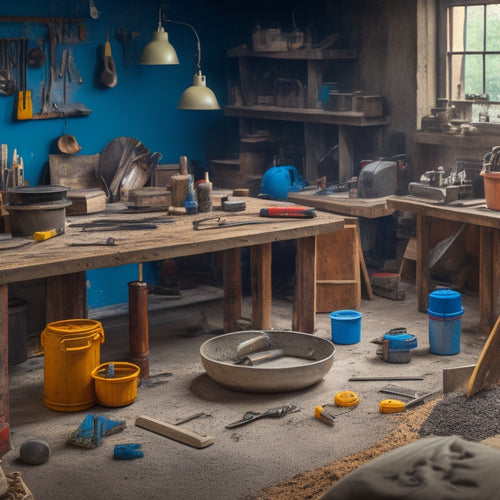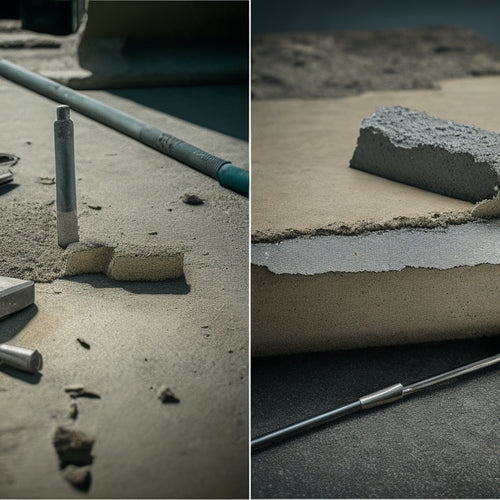
What Tools Do You Need for a Concrete Wall
Share
You'll need a range of specialized tools to successfully build a concrete wall. Start with essentials like mixers, trowels, levels, and wheelbarrows for mixing and transporting concrete. Then, add masonry tools like jointers, grout floats, and pointing trowels for preparing and finishing joints. Don't forget power tools like circular saws and diamond blades for cutting concrete, as well as safety gear like safety glasses, dust masks, and steel-toed boots. Finally, consider specialized finishing tools like tampers, edgers, and stamp mats to achieve a professional-looking finish. With the right tools, you'll be well on your way to a strong and durable concrete wall - and there's more to learn to get it just right.
Key Takeaways
• Essential tools for a concrete wall project include a mixer, trowel, level, wheelbarrow, and shovel for mixing and applying concrete.
• Masonry tools like jointers, grout floats, and pointing trowels are necessary for preparing and finishing joints and surfaces.
• Power tools like circular saws and demo saws with diamond blades are required for cutting concrete accurately and safely.
• Safety equipment such as safety glasses, dust masks, ear protection, and steel-toed boots are crucial for protecting yourself from hazards.
• Specialized finishing tools like tampers, edgers, and stamp mats are necessary for achieving professional-looking finishes and textures.
Essential Tools for the Job
You'll need the following essential tools to guarantee a successful concrete wall project:
A mixer for mortar mixing,
A trowel for applying and smoothing the mixture,
And a level to ascertain the wall is straight and even.
A wheelbarrow or mixing bucket is necessary for transporting and mixing the concrete,
While a shovel or scoop is required for filling the mixing bucket with the correct materials.
For wall reinforcement, you'll need wire mesh or rebar,
As well as wire cutters or bolt cutters to shape and secure the reinforcement.
A rubber mallet or hand tamper is also necessary for tapping and compacting the concrete as you lay it.
Don't forget safety gear like gloves, safety glasses, and a dust mask to protect yourself from the physical demands of the job.
With these essential tools, you'll be well-equipped to tackle your concrete wall project with confidence and precision.
Masonry Tools and Accessories
Five specialized masonry tools are vital for finishing and refining your concrete wall:
a jointer or joint chisel for cleaning and preparing joints,
a grout float for spreading and smoothing grout,
a grout sponge for removing excess grout,
a pointing trowel for applying and shaping mortar,
and a masonry brush for applying and removing excess mortar.
These tools will help you master various masonry techniques, such as jointing, grouting, and pointing.
To get the most out of your tools, it's important to maintain them properly. Here are some tips:
-
Clean and dry your tools after each use to prevent rust and damage.
-
Store tools in a dry place, away from direct sunlight and moisture.
-
Regularly inspect and sharpen your tools to guarantee they remain effective.
- Lubricate moving parts to reduce wear and tear.
Power Tools for Cutting
With your masonry tools in top condition, you're ready to tackle the task of cutting through concrete, which requires a different set of power tools. For efficient concrete cutting, you'll need a reliable circular saw or a high-powered demo saw. These power tools are designed to withstand the rigors of cutting through concrete, and they're available in various sizes and configurations to suit your specific needs.
When it comes to blades, you have several diamond blade options to choose from. A diamond blade with a high concentration of diamonds is ideal for cutting through dense concrete, while a blade with a lower concentration is better suited for softer materials. You'll also need to take into account the blade's thickness and its ability to withstand heat buildup.
To guarantee accurate cuts, master circular saw techniques such as using a steady, consistent motion and applying gentle to moderate pressure. It's also essential to maintain a firm grip on the saw and keep your body positioned at a safe distance from the cutting area.
Safety Equipment and Gear
Cutting through concrete can be hazardous, so donning the right safety equipment and gear is essential to protecting yourself from harmful debris, dust, and noise. You wouldn't want to compromise your health or safety while working on a concrete wall project. That's why it's important to invest in high-quality safety gear.
Here are the must-haves for your safety arsenal:
-
Safety glasses: Protect your eyes from flying debris and dust with ANSI-approved safety glasses.
-
Dust mask: Prevent inhalation of concrete dust and silica particles with a NIOSH-approved dust mask.
-
Ear protection: Reduce noise exposure with earplugs or earmuffs that meet OSHA standards.
- Steel-toed boots: Wear rugged, slip-resistant boots with a steel toe to protect your feet from heavy objects and sharp edges.
Specialized Concrete Finishing
You'll need to move beyond basic concrete work and focus on specialized finishing techniques to achieve a high-quality, visually appealing concrete wall. This requires mastering various smoothing techniques and applying decorative finishes to create a unique, professional-looking surface.
To get started, you'll need the right tools for the job. Here's a breakdown of the essential tools and materials for specialized concrete finishing:
| Tool/Material | Purpose | Description |
|---|---|---|
| Tamping tool | Smoothing | Used to remove air pockets and smooth out the concrete surface |
| Edger | Smoothing | Creates a clean, defined edge around the concrete wall |
| Stamp mat | Decorative finish | Adds texture and pattern to the concrete surface |
| Acrylic sealer | Decorative finish | Enhances color and protects the concrete from damage |
Frequently Asked Questions
Can I Use a Regular Drill Bit for Drilling Into Concrete?
Don't even think about using a regular drill bit for drilling into concrete - it'll just burn out or break.
You need specialized drill bit types, like carbide-tipped or diamond-coated bits, designed for concrete drilling techniques.
These bits are built to withstand the intense heat and friction generated when drilling into concrete.
With the right bit, you'll get a clean, precise hole without damaging your drill or the concrete.
How Do I Prevent My Tools From Rusting After Use?
When you're done drilling into concrete, don't forget to protect your tools from rust.
Proper tool maintenance is key to extending their lifespan. Clean your tools thoroughly with a wire brush and mild detergent to remove any concrete residue.
Dry them completely, then apply a rust-inhibiting coating or oil to prevent corrosion. Store them in a dry place, away from direct sunlight.
What Is the Ideal Temperature for Working With Concrete?
As you're no stranger to rust-proofing your tools, now it's time to tackle the best temperature for working with concrete.
You know the drill - concrete curing is a delicate dance. Temperature effects can make or break the process.
Aim for a sweet spot between 50°F and 70°F (10°C and 21°C) for ideal hydration and strength development.
Anything outside this range can lead to compromised results.
Can I Use a Hammer to Tap Concrete Finishing Tools?
When it comes to tapping concrete finishing tools, you're smart to question whether a hammer is the right choice.
While a hammer can work, it's not the most effective option.
Instead, invest in a tapping tool or a bull float with a sturdy handle, designed specifically for tapping techniques.
These tools guarantee ideal tool compatibility, allowing you to achieve a smooth, even finish with precision and control.
Do I Need a License to Build a Concrete Wall?
As you commence on this behemoth of a project, remember that ancient Egyptian pharaohs didn't build their pyramids without a solid plan.
You, too, need to guarantee you're complying with modern-day building codes and licensing requirements.
Check with your local authorities to determine if a license is required for building a concrete wall.
Depending on the scope and location of your project, you might need permits or special certifications.
Don't risk your reputation or safety - get informed before you start pouring concrete.
Conclusion
As you stand before the concrete wall, your arsenal of tools at the ready, remember that the right gear is the foundation upon which your project's success is built.
With each carefully chosen instrument, you're not just constructing a barrier, you're crafting a masterpiece.
The hum of power tools, the scratch of trowels, and the rustle of safety gear all harmonize to create a symphony of skill and precision.
Your wall will rise, a testament to your expertise, a monument to your mastery.
Related Posts
-

What Tools Do You Need for Concrete Flooring
You'll need a thorough arsenal of specialized tools to achieve a high-quality, professional-looking concrete floor, i...
-

Budget-Friendly Tools for DIY Decorative Concrete Profiling
You can achieve professional-grade decorative concrete results on a budget by investing in the right combination of e...
-

Top Tools for Concrete Adhesion Success
When it comes to concrete adhesion success, you'll need to wield the right tools and techniques to guarantee a strong...


